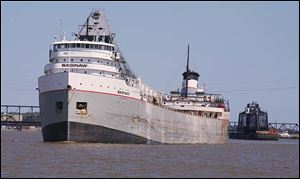
The Port of Toledo striving to diversify its freight business
9/8/2007
The Saginaw enters the Port of Toledo, where iron ore (taconite) and coal sector tonnage show double-digit gains.
One need only look through the chain-link fence at the Port of Toledo general-cargo dock to see the fruit of efforts by the Toledo-Lucas County Port Authority and its stevedore to diversify the local waterborne freight business.
Row upon row of steel pipe, imported from Germany for construction of a natural-gas pipeline across the central United States, is stacked around much of the dock's south end.
Inventory surges when a ship comes in with a fresh 20,000-ton load - about 1,000 pipe sections - then dwindles as the sections are loaded onto railcars in lots of nine or 11 for shipment out of Toledo.
"Revenuewise, it's a good cargo because it's labor-intensive and requires a lot of equipment," said Jason Lowery, director of business development for Midwest Terminals of Toledo International, which is approaching the second anniversary of its takeover of the Toledo dock operation.
At the other end of the wharf, a cargo common elsewhere on the local waterfront but new to the general-cargo dock - taconite pellets - sat in a huge pile on a recent afternoon, awaiting an outbound freighter to take it to Quebec City.
Historically, Toledo has been only a receiver of taconite, a processed form of iron ore consumed by steel mills.
But this year, China's continuing heavy-construction boom has boosted its steel-making demand so much that it has become economical to ship Minnesota ore to Toledo in 1,000-foot Great Lakes vessels, reload it here into smaller ships capable of transiting the St. Lawrence Seaway, then reload it once again at Quebec City onto larger ocean vessels.
Mr. Lowery wouldn't say exactly how much revenue the new pipe and taconite business is bringing in, but that it will help the port post an overall revenue and volume increase this year even though some of its historic cargoes, including steel, aluminum, and lumber, have declined because of the weak housing-construction market.
The iron ore "is not necessarily a long-term proposition," Mr. Lowery conceded, "but it shows the bulk transfer potential" at Toledo.
The pipe, by contrast, is a cargo for which Midwest sees a continuing market.
"That will add more to the bottom line [than the taconite transload] even though it's just an eighth or a sixth of the volume," Mr. Lowery said.
"And there's pipelines being built at a pretty rapid pace right now. They won't all be as big as this one, but the vessel line sees more coming."
The pipe leaves Toledo in groups of as many as 30 railcars at a time. Securing enough pipe-loading railcars has been a problem at times, Mr. Lowery said, but Midwest has been working with the railroads to improve that situation.
The pipe traffic started last fall with two shiploads, with 12 to 14 more coming this year, and another six or seven expected next year, said Joe Cappel, the port authority's seaport marketing representative.
"The lumber business has really fallen off because of the economy, but our capacity to handle it is proven and it will come back," Mr. Cappel said.
"In the meantime, we're going to position ourselves as the most experienced pipeline-handling terminal on the Great Lakes."
Through July, overall cargo tonnage across Toledo's various docks was up 4.22 percent compared with the first seven months of 2006, though the number of vessels calling declined by 14.
The iron ore (taconite) and coal sectors showed double-digit gains, while grain, general cargo, and dry-bulk sectors were down compared with last year.
Mr. Lowery and Warren McCrimmon, the port authority's seaport director, both expect the 2007 shipping season to end robustly.
A surge in pig-iron shipments, which electric-arc steel mills use for raw material instead of iron ore, is expected later this year.
Mr. McCrimmon said he believes grain may rebound too because of heavy European demand, "though I'm not sure we will hit the numbers of last year" when grain volume hit a recent peak.
Port authority officials also are pleased that construction of the new "high-bay" facility at the Toledo Shipyard has begun in recent weeks after being delayed nearly a year by the withdrawal of a federal grant for the project.
The first phase of the building, under whose roof shipyard contractor Ironhead Marine will be able to build large vessel components or other heavy-industrial assemblies, should be finished by Christmas and ready for occupancy by early January, Mr. McCrimmon said.
"It looks good, but it will look even better when it's done," he said last week while surveying the building's steel skeleton.
Contact David Patch at:
dpatch@theblade.com
or 419-724-6094.